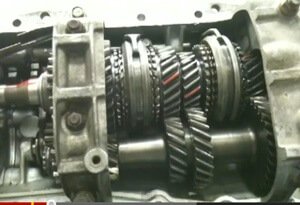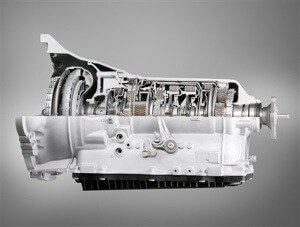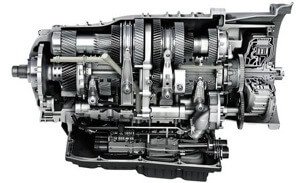Car Transmissions
In this article we'll dive into car transmissions and discuss their various aspects and expand upon what may have been taught in online drivers ed. Transmissions are required because cars are run at a wide variety of speeds and situations. The job of the transmission is to match the power output of the engine to car speed required by the driver. Cars are driven at a wide variety of speeds, ranging from stopped to speeds in excess of 60 MPH in varying conditions. The car engine develops its power over a wide range of RPM (Revolutions Per Minute) with greatly varying torque output. The problem is that the road requirements must be matched to engine output so that drivers can get the required performance from their car over these varying conditions. One method of doing this is by varying the engine power with the accelerator pedal while the second is by using a variety of gear ratios to couple the engine to the rest of the drivetrain. The method used by all cars powered by internal combustion engines is the transmission, whose job is to provide the matching capability between engine and road.
The car transmission has been around from the beginning of the automobile industry but has changed greatly over the years. Early on, transmissions were all "standards", meaning that the driver used a clutch and manually shifted the transmission into the proper gear. Automatic transmissions were eventually created with the capability and control logic to perform the shifting and clutching for the driver. The most recent transmision technology is the "automated manual" transmission, which provides the best of both worlds.
The three main types of car transmissions are manual, automatic, automated manual.
 Manual Transmissions were first on the scene and indeed the simplest form of transmission. Early transmissions only had 2 gears while today's modern transmissions can have upward of 7 gears. Having more gears allows for better matching of engine to conditions resulting in a smoother ride, increased power delivery over a wide range, and in many cases increased fuel mileage. The clutch actually disengages the engine from the rest of the drivetrain, which is required when bringing the car to a stop and also when shifting gears with a manual transmission. Today, in the U.S. a very small fraction of cars produced have a manual transmission and their sale is mainly to driving enthusiasts. However, in other areas of the world, in particular Europe, manual transmissions are more popular than in the U.S.
Manual Transmissions were first on the scene and indeed the simplest form of transmission. Early transmissions only had 2 gears while today's modern transmissions can have upward of 7 gears. Having more gears allows for better matching of engine to conditions resulting in a smoother ride, increased power delivery over a wide range, and in many cases increased fuel mileage. The clutch actually disengages the engine from the rest of the drivetrain, which is required when bringing the car to a stop and also when shifting gears with a manual transmission. Today, in the U.S. a very small fraction of cars produced have a manual transmission and their sale is mainly to driving enthusiasts. However, in other areas of the world, in particular Europe, manual transmissions are more popular than in the U.S.
 Automatic Transmissions became popular in the 1930's and today the majority of cars are equipped with these types of transmissions. They are popular because the driver does not have to worry about shifting gears or dealing with a clutch pedal. As the level of traffic increased in the 20th century, the benefits of an automatic transmission became apparent by making it easier to drive in traffic. The clutch in a manual transmission is replaced by a torque converter, which is a hydraulic coupler between the engine and the transmission. The gears in a manual transmission are replaced by a series of bands and planetary gears which are also under hydraulic control.
Automatic Transmissions became popular in the 1930's and today the majority of cars are equipped with these types of transmissions. They are popular because the driver does not have to worry about shifting gears or dealing with a clutch pedal. As the level of traffic increased in the 20th century, the benefits of an automatic transmission became apparent by making it easier to drive in traffic. The clutch in a manual transmission is replaced by a torque converter, which is a hydraulic coupler between the engine and the transmission. The gears in a manual transmission are replaced by a series of bands and planetary gears which are also under hydraulic control.
 Automated Manual Transmissions are a relatively new innovation originally invented by Porsche in 1980 as part of their racing efforts. These types of transmissions provide the best of both worlds providing fast and smooth gear changes that can be completely controlled by the driver when desired or can be run in an automated mode. The technology is composed of a pair of clutches, one driving even gears and the other driving the odd gears. Operation is under computer control allowing for varying degress of speed and smoothness. The most interesting aspect of this technology is that power to the wheels from the engine is uninterrupted during the shifting process.
Automated Manual Transmissions are a relatively new innovation originally invented by Porsche in 1980 as part of their racing efforts. These types of transmissions provide the best of both worlds providing fast and smooth gear changes that can be completely controlled by the driver when desired or can be run in an automated mode. The technology is composed of a pair of clutches, one driving even gears and the other driving the odd gears. Operation is under computer control allowing for varying degress of speed and smoothness. The most interesting aspect of this technology is that power to the wheels from the engine is uninterrupted during the shifting process.
